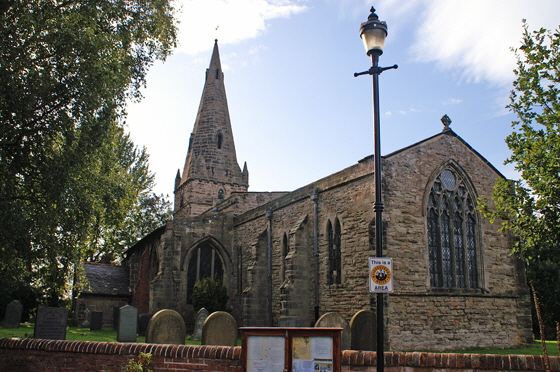|
|
|||||||||||||||||||||||||||||
|
was added in 1315, the east window replaced in the Decorated style and that’s about it in terms of the church’s development, apart from the usual window alterations. All of our mediaeval parish churches have seen the vagaries of centuries of turbulent history. Ratcliffe, though, has had crises all of its own which shine a spotlight on the venality of the Church in earlier centuries. At the church’s foundation the manor, and thus the church, of Ratcliffe was in the hands of a Thane of William I. This might account for its been built relatively early in the Norman era. After William’s death the manor passed through various baronial hands before in 1117 the Baron of Halton (in Cheshire) used Ratcliffe in the foundation of Runcorn Priory. This was the start of Ratcliffe’s role of being, to quote Bob Dylan, a “Pawn in the Game” of Church politics and finances. Runcorn Priory folded quickly and Ratcliffe found itself now owned by the new priory at Norton, also in Cheshire. Ratcliffe itself was mother church to chapels at Kingston on Soar (described on this website) and Thrumpton. Ratcliffe would have jealously guarded its lucrative rights, denied to the chapels, to perform marriages and burials. Located close to a major river crossing, Ratcliffe’s own revenues were probably substantial. In turn Norton would have appropriated substantial parts of Ratcliffe’s own revenues. It was a murky, acquisitive world. “Big fleas have little fleas upon their backs to bite ‘em. Little fleas have smaller fleas and so ad infinitum”. Things took a more dramatic turn in fourteenth century. In 1321 the French Pope John XXII, at a time when the papacy was based in Avignon, attempted to give Ratcliffe to his mate Cardinal Bertrand du Pouget who promptly appointed his own nominee as priest. Yes, Popes could do that sort of thing. Edward II, no less, forbade it. The Pope, reasonable man that he was, blamed the Prior of Lenton (Notts) whom he had charged with inducting Pouget’s nominee and excommunicated him, an unthinkable and disproportionate punishment. The Pope subsequently pleaded with Edward but was thwarted. Arguments about who had the right to appoint the priest (the “advowson”) at Ratcliffe rumbled on with a remarkable outcome. In 1358 Norton Priory granted the advowson to one John de Winwick, Treasurer of York Minster. When John died there was an almighty argument about his will but eventually the advowson was granted to Oriel College, Oxford. Richard de Winwick, brother of John, gave the rectorship to one William Julyan. In the meantime, Walter Levenaunt, a canon of Exeter Cathedral, decided to challenge the appointment. Henry III found out that Levenaunt intended to expel Julyan. The Pope Urban VI demanded Julyan be removed but Winwick, unsurprisingly, preferred to stand upon the support of King Henry who lived rather nearer to Ratcliffe than the Pope did and refused. In a remarkable turn of events, on 9 October 1381 Levenaunt arrived with men from Exeter to enforce things. The parish resisted, Julyan took refuge in the church tower and the church door was barred. at which point the assailants tried to burn it down before they were put to flight. The church still bears evidence of the fire, believe it or not! Levenaunt was arrested and imprisoned. Eventually he was pardoned after arguing that he had purchased - note that word - the advowson through the proper formalities in the Papal Court in Rome! These incidents paint a vivid picture of the worldly avarice of the mediaeval clergy and the continuing claims on the part of Rome to be able to dispose of churches and clerical positions. What, you might wonder, gave a Canon of a Cathedral in Devon the ambition to travel to Rome to buy the rectorship of a church in Nottinghamshire; and how come he had the means to do so? Do you ever wonder why there was a Reformation? Anyway, that was a long digression. What will bring you to this church is none of the above but the impressive collection of Sacheverall monuments that dominate this somewhat untidy and threadbare church. There are four. all fashioned in Chellaston (Derbyshire) alabaster spanning the period 1558-1625 - the first year of Elizabeth I’s reign to the first year of Charles I’s! . All were restored in 1973 and so they are in good condition and provide a fascinating study in the changes of fashion in monumental and costume design over a seventy year period. |
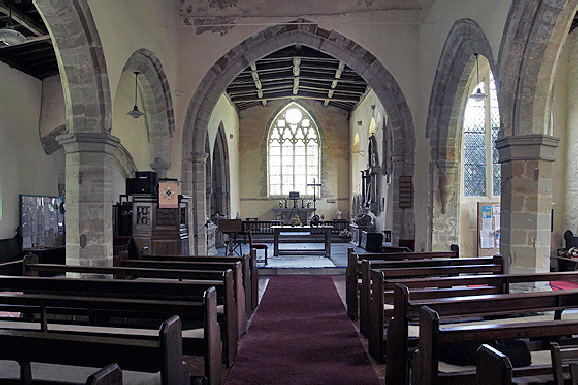 |
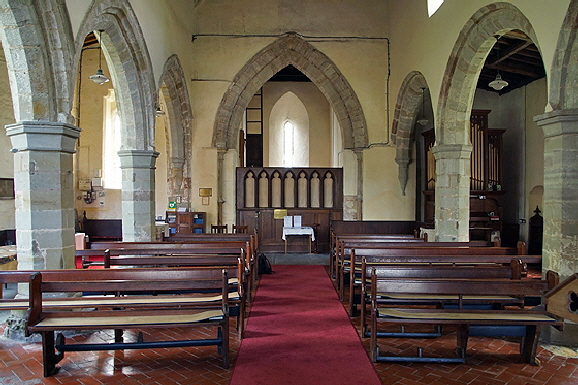 |
|
Left: The view to the east. The east window is of 1315. I tend to the view that the wide chancel arch dates from that time rather than of 1290 when the chancel was extended or of of the earlier rebuild in 1215. The north and south arcades are slightly different in profile even though they were part of the same building phase of 1290. Right: Looking towards the west. The tower is of 1290 and the west window is still of the Early English style rather than of the Decorated as is, less obviously, the tower arch. One wonders why the nave arch pillars and capitals are of slightly different profile? It suggests that they did not follow uninterruptedly one from the other or else that a new contractor-mason was employed. Arch and capital profiles followed templates fashioned by the contractor-mason (or freemason or - less likely - master mason). It is hard to see why one would make such minor changes. Quite likely the original mason took his with him, perhaps even to his next contract. |
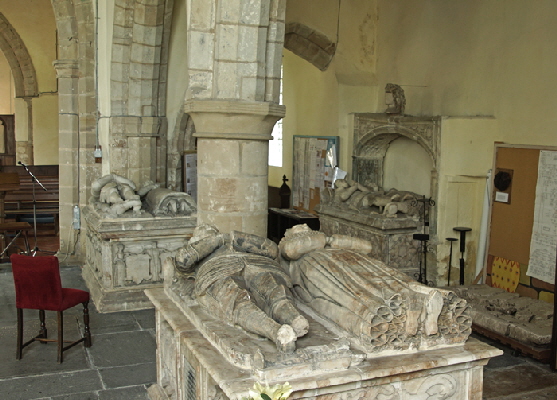 |
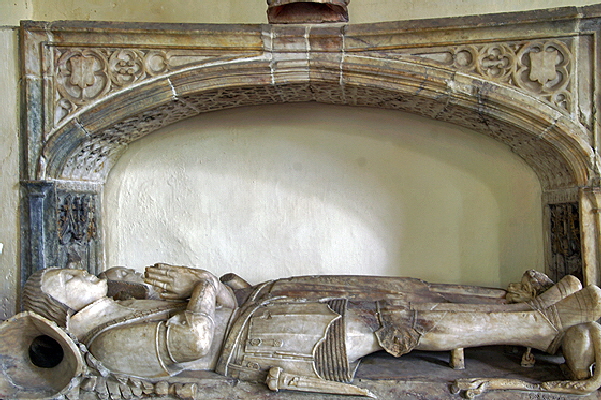 |
|||||||||||||||||||||||||||||||||||||||||||||
|
Left: Three Sacheverall monuments dominating the north east of the church. Against the wall is the canopied tomb of Randolphus aka Ralph (d.1539) and Cicely (1538). The canopy covers only Cicely who died first so it is likely that Ralph was added. Ray State (see footnote), who lives in Ratcliffe and who is the greatest authority living or dead on alabaster monuments in this country and who has studied these monuments in the most exhaustive detail, believes that this is actually an effigy of Ralph’s Uncle Richard brought in from Leicester in 1554, some fifteen years after Ralph’s death. The monument to its left is of Henry (d.1558) whose feet were amputated posthumously and his wife. In the foreground is the monument of another Henry (d.1585) and and his wife, Jane Ireton. Right: Ralph (or is it Richard?) and Ciceley. |
||||||||||||||||||||||||||||||||||||||||||||||
 |
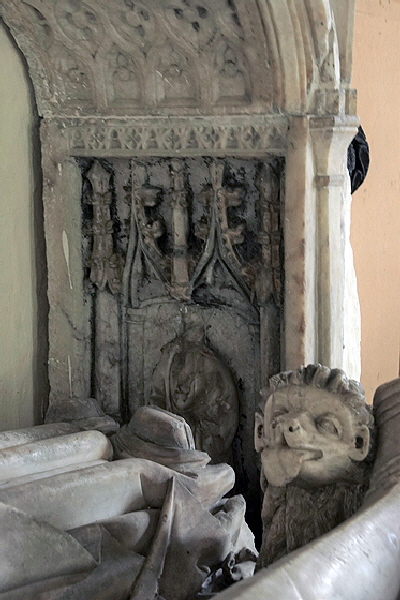 |
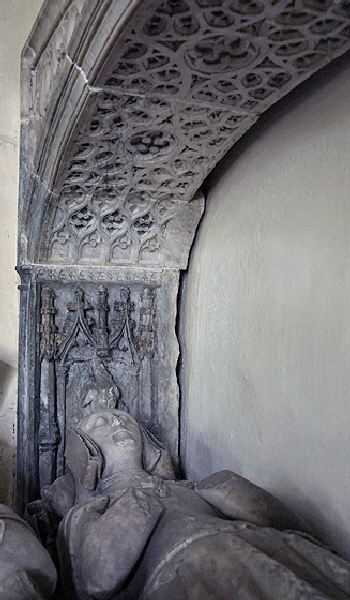 |
||||||||||||||||||||||||||||||||||||||||||||
|
Left: Ralph has his feet resting on a lion. Centre: The canopy is richly decorated on its underside. The lion upon whom Ralph is resting his feet is sticking his tongue out cheekily. Or is he contemplating Ralph as his next snack? Right: Cicely rests under the canopy which covers only herself. She had lost her hands, sadly. |
||||||||||||||||||||||||||||||||||||||||||||||
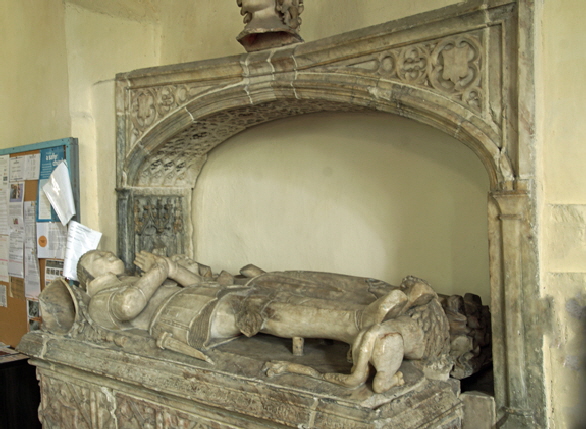 |
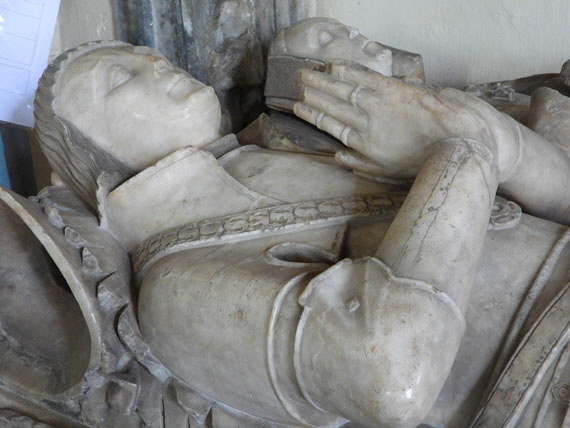 |
|||||||||||||||||||||||||||||||||||||||||||||
|
Left: Ralph and Cicely. Note the helmed head above the canopy. As Ciceley was the only original person here, the head was clearly put here when Ralph’s figure was added to the monument. Right: Ralph and Ciceley. Ralph is wearing the “esses” chain favoured by the officials under the Lancastrian kings. Geograph.co.uk in describing this monument say that Ralph supported the Lancastrians during the Wars of the Roses. This cannot be right. He was born in 1506, some twenty years after the battle of Bosworth which placed the Tudor Henry VII on the throne. The esses collar was, moreover, no longer worn after Bosworth. This supports Ray State’s contention that this effigy is not of Ralph but of his Uncle Richard. Even this is slightly problematical. Richard himself would have been only 16 at the time of Bosworth, That was, surprisingly to modern generations, considered to be perfectly old enough to be fighting in battle but was it old enough for him to be considered worthy of the collar? I don’t know the answer to that. Richard died in 1533, aged 66. This is obviously not the face of a 66 year old. It was the practice to represent people as they were at the age of 33 when Christ died and, therefore, the sculptors could not possibly represent the man’s face accurately. He may have looked nothing like this at any time in his life! The carving here is actually quite unrefined considering the potential of alabaster for really fine sculptural work. Ray State also, incidentally, gave the insight that the alabaster sculptural workshops were not students of plate armour: each workshop probably had a single suit which they copied for a very long time! Photo: Bonnie Herrick) |
||||||||||||||||||||||||||||||||||||||||||||||
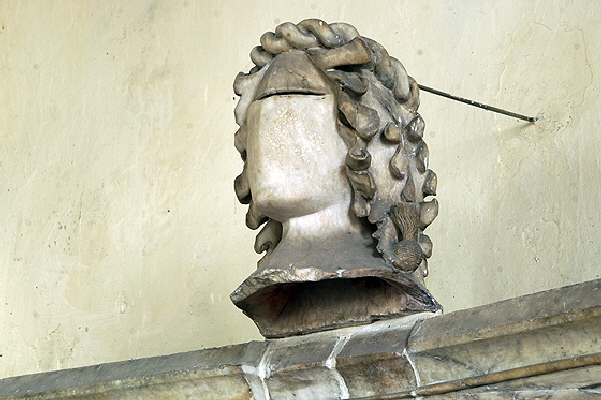 |
||||||||||||||||||||||||||||||||||||||||||||||
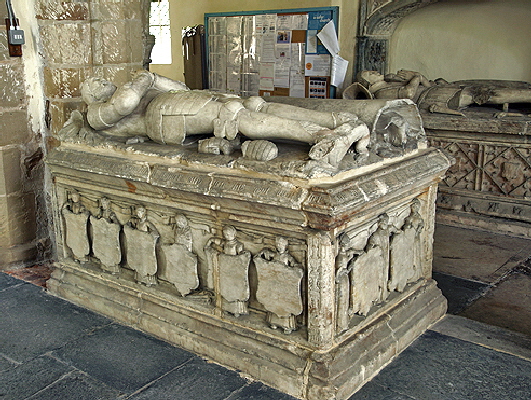 |
||||||||||||||||||||||||||||||||||||||||||||||
|
Left: The curious helmed head above the Ralph Sacheverell monument. It has very clearly been removed from elsewhere. Right: The monument to Henry Sacheverall (d.1558), son of Ralph, and his first wife Lucy. This too is of Chellaston alabaster and Ray State asserts it was carved at the Royley Workshop in Burton-on-Trent. He does not appear to have led a distinguished life and nor was he apparently knighted. |
||||||||||||||||||||||||||||||||||||||||||||||
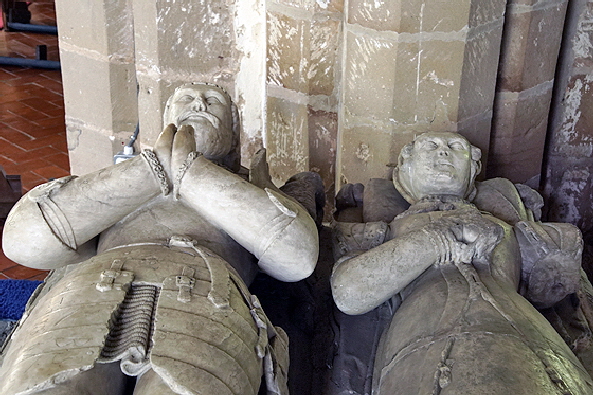 |
||||||||||||||||||||||||||||||||||||||||||||||
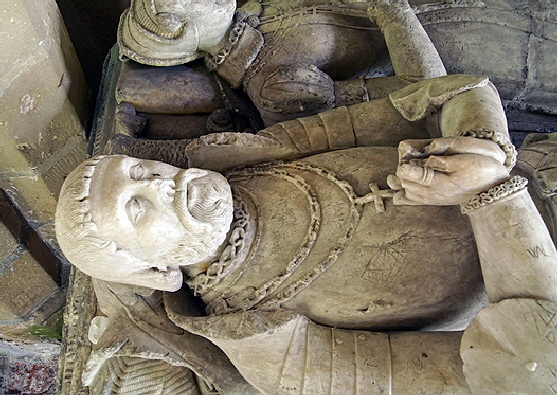 |
||||||||||||||||||||||||||||||||||||||||||||||
|
Left: The heads of Henry and Lucy. These two are clearly not represented as when they were 33. Lucy looks positively matronly. Right: Henry with some sort of chain of office and across on his chest. |
||||||||||||||||||||||||||||||||||||||||||||||
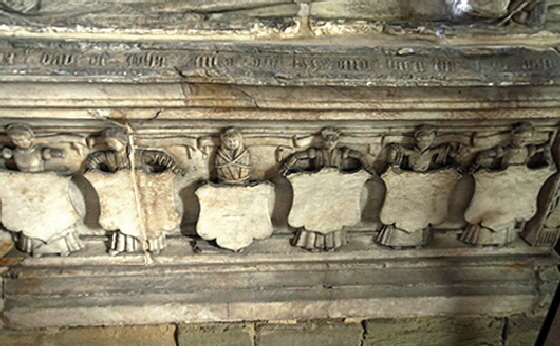 |
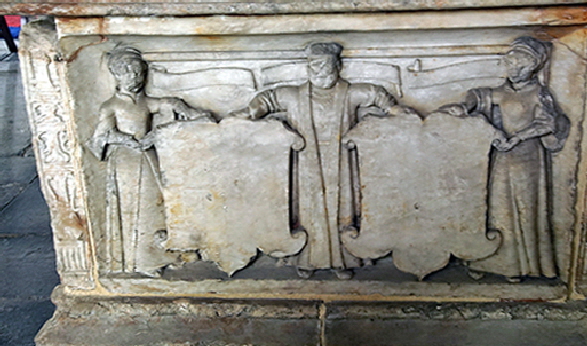 |
|||||||||||||||||||||||||||||||||||||||||||||
|
Left and Right: The Henry and Lucy monument is surrounded by images of their children holding shields. Note the shrouded figure of a child who died in birth. |
||||||||||||||||||||||||||||||||||||||||||||||
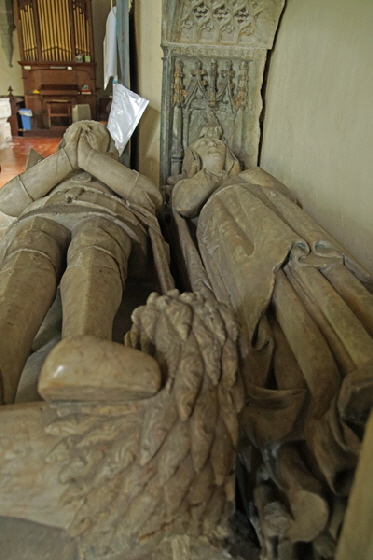 |
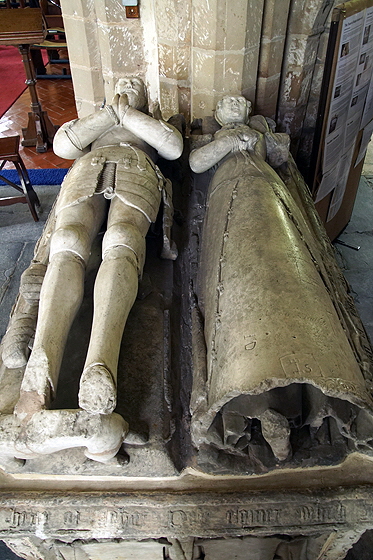 |
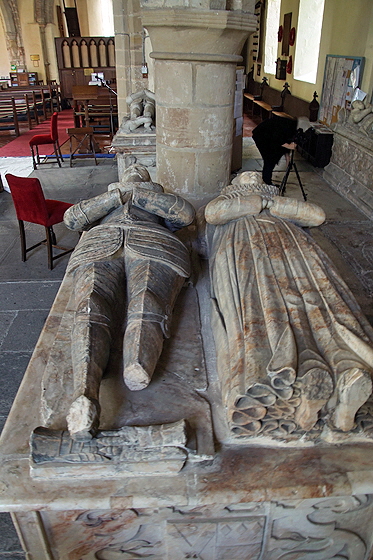 |
||||||||||||||||||||||||||||||||||||||||||||
|
Three Sacheverell couples. Left: Ralph and Cecily. Centre: Henry and Lucy. Right: Another Henry (d.1585) and his wife, Jane Ireton |
||||||||||||||||||||||||||||||||||||||||||||||
 |
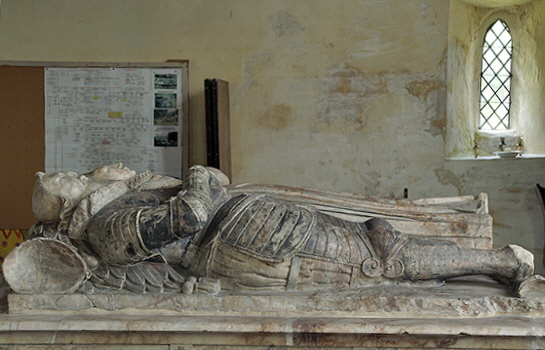 |
|||||||||||||||||||||||||||||||||||||||||||||
|
Left: The monument to Henry Sacheverall and Jane Ireton. Of the three monuments we have seen so far this is much the best piece of craftsmanship. Ray State avers that the alabaster is from Fauld near Burton-on-Trent and that it was fashioned in the Hollemans workshop in Burton. The red veining of the alabaster is quite conspicuous here. The “weepers” around the base - the Sacheverall children - are stiffly portrayed and, as we will see - figurative rather than attempting to portray the children themselves. Right: You can see readily that the plate armour has become much more elaborate and more finely carved. |
||||||||||||||||||||||||||||||||||||||||||||||
 |
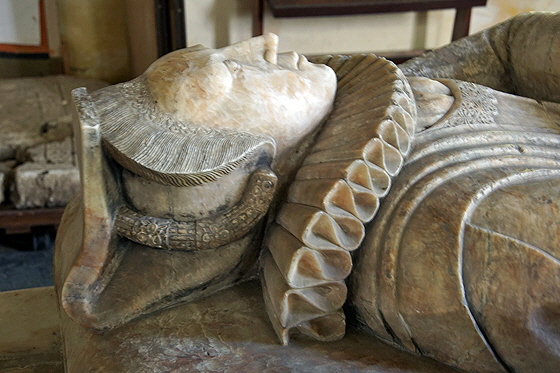 |
|||||||||||||||||||||||||||||||||||||||||||||
|
Left: The monument as seen from the north side. In the background is the wall monument to yet another Henry Sacheverell and his wife, of which more anon. Right: Jane Ireton. She was of the family of Henry Ireton who would marry the daughter of Oliver Cromwell a few decades later. Note how the ruff is now in vogue, this being the era of Elizabeth I. |
||||||||||||||||||||||||||||||||||||||||||||||
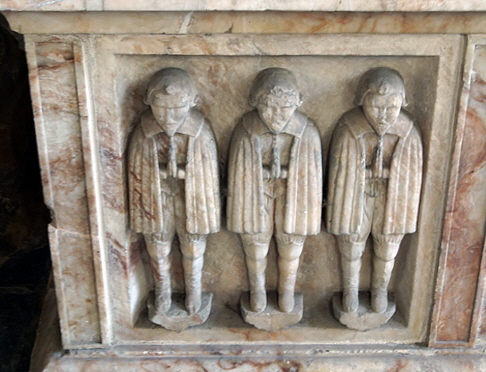 |
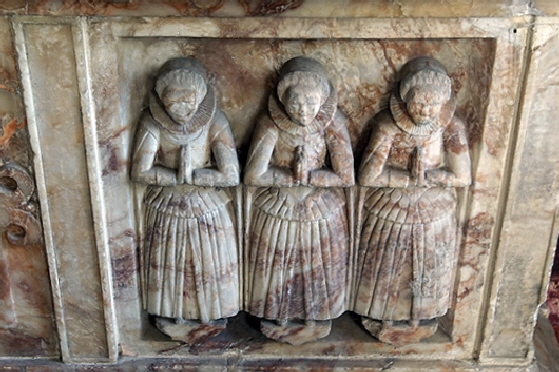 |
|||||||||||||||||||||||||||||||||||||||||||||
|
The male and the female weepers. Surely they are not sextuplets? Two sets of triplets...? |
||||||||||||||||||||||||||||||||||||||||||||||
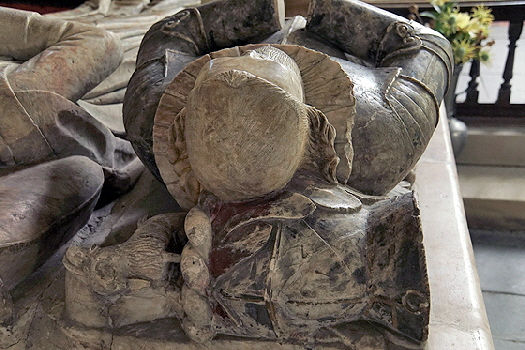 |
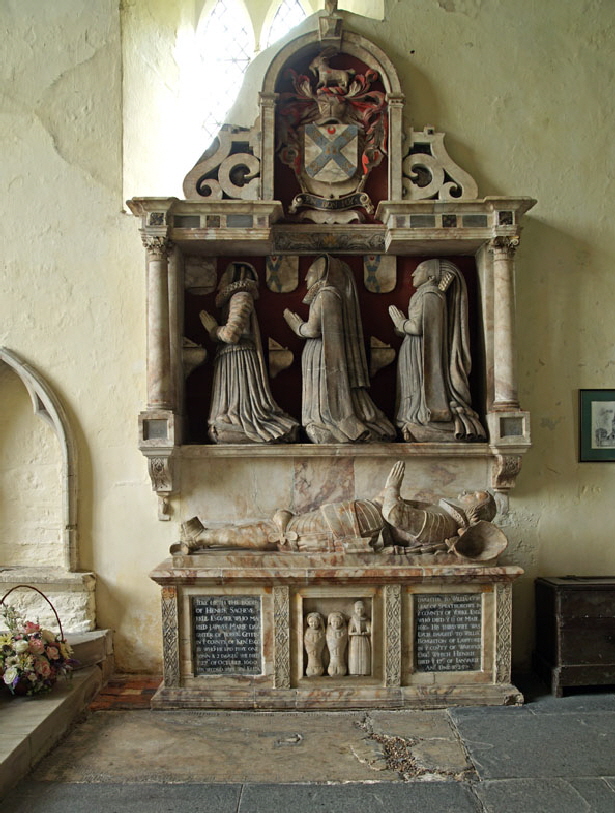 |
|||||||||||||||||||||||||||||||||||||||||||||
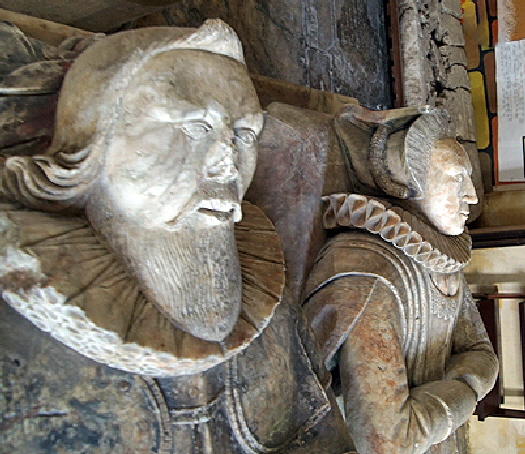 |
||||||||||||||||||||||||||||||||||||||||||||||
|
Left Upper: The head of Henry Sacheverell resting on his helm. To its left is a dog. Left Lower: Sir Henry Sacheverell and Jane Ireton. Right: The monument to (another) Henry Sacheverell (d.1585), grandson of Ralph. This too is in Fauld alabaster and also from the Hollemans workshop. The amber veining of the stone is particularly conspicuous. Only Henry is lying on table tomb. Each of his three wives is shown in the wall recess above his head, each dressed as they were at the times of their deaths. |
||||||||||||||||||||||||||||||||||||||||||||||
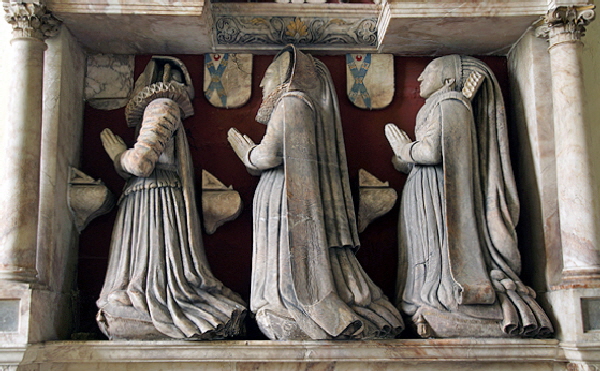 |
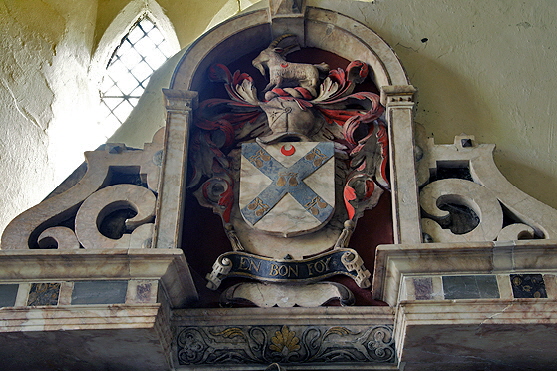 |
|||||||||||||||||||||||||||||||||||||||||||||
|
Left: The Three Wives of Henry Sacheverell do not have the same ring as the Six Wives of Henry the Eighth and, looking at their effigies here (says he, waspishly) nor did they have the looks. But their heads are all attached to their shoulders and Henry obviously thought enough of the three of them for then to be there on his monument. Right: The Sacheverell arms atop the monument - see it also behind the wives. |
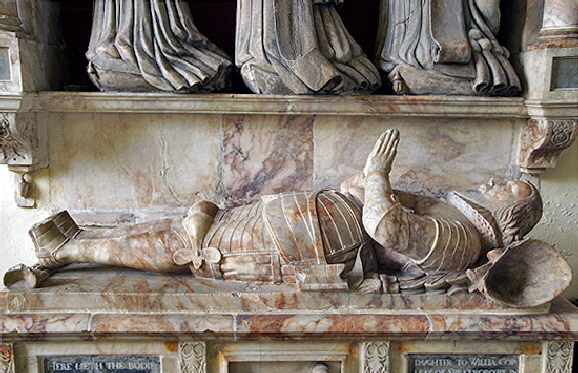 |
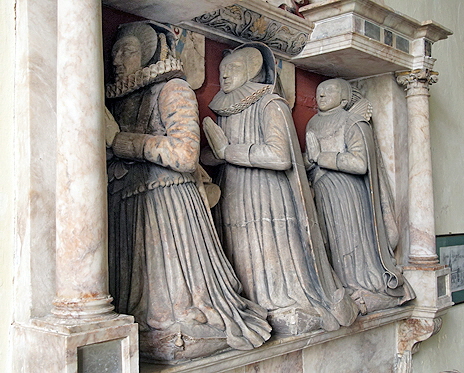 |
|||||||||||||||||||||||
|
Left: Sir Henry in his eternal repose. Right: The three wives. Although they are not identical, the shapes of their heads are pretty similar. What we are surely seeing here is the stonemasons working with no real idea of what they actually looked like - presumably the same problem they had with the weepers on the Henry/Jane Ireton monument. |
||||||||||||||||||||||||
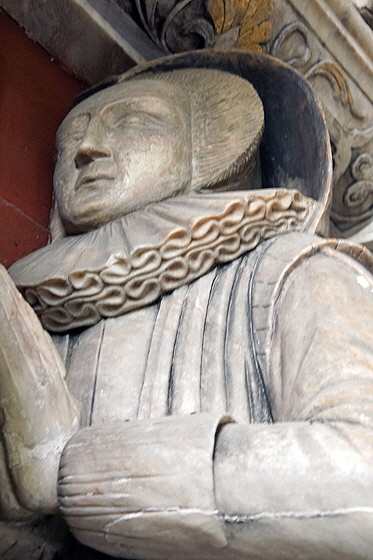 |
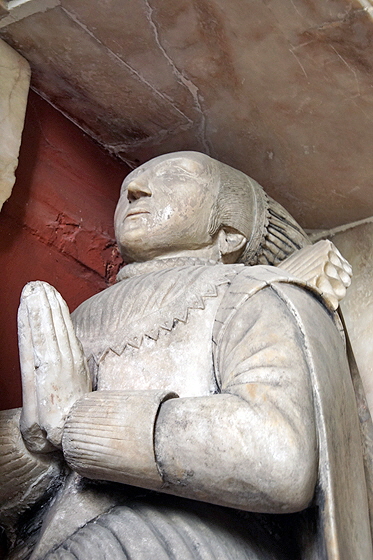 |
 |
||||||||||||||||||||||
|
Left and Centre: Two of the three wives of Henry Sacheverall. See if you agree with me that the faces are pretty well slight variations on a theme. The costumes, especially the headdresses are, however, very different. Right: The font |
||||||||||||||||||||||||
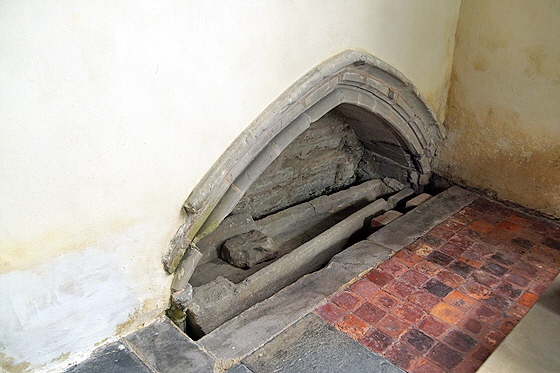 |
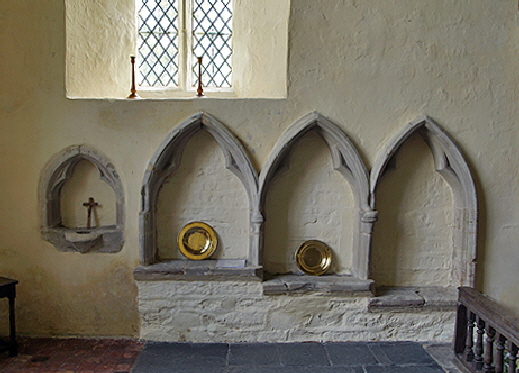 |
|||||||||||||||||||||||
|
Left: A stone coffin sits within what might have been - or become - an Easter Sepulchre at the east end of the north aisle. This was probably the founder’s tomb. Note the ancient tiles.Right: The spartan triple sedilia and piscina. |
||||||||||||||||||||||||
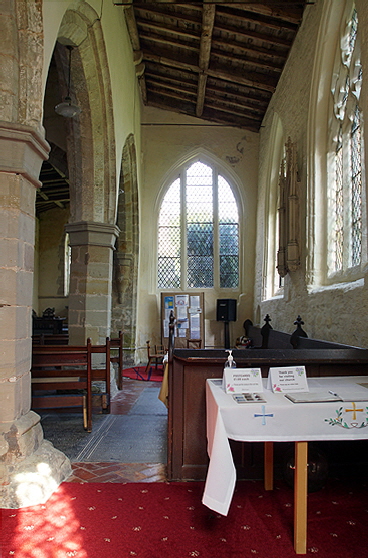 |
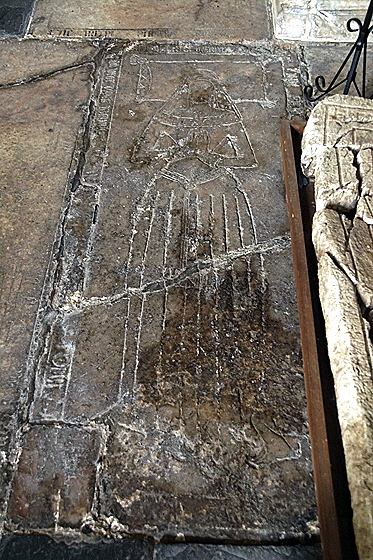 |
 |
||||||||||||||||||||||
|
Left: The south aisle. Centre: The incised floor slab of Isabella (d.1486) wife of John Babington, who was killed at the Battle of Bosworth a year earlier. Just look at that waist! The Babington family were prominent in the area and at nearby Kingston on Soar you can see the hugely impressive monument of Sir Anthony Babington who died in 1536 as well as the Babington chantry chapel. In fact, Kingston was a Chapel of Ease to Ratcliffe until that time. Right: A somewhat crude bifora bell opening to the tower which totally reflects its late thirteenth century building date. |
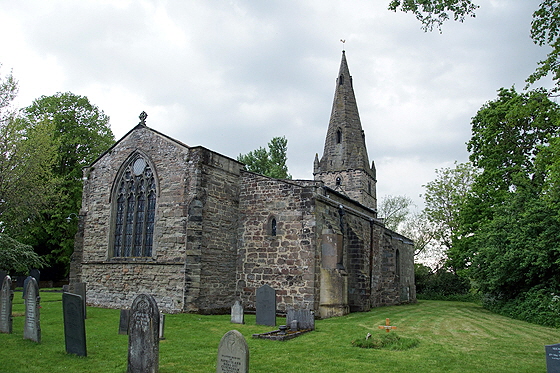 |
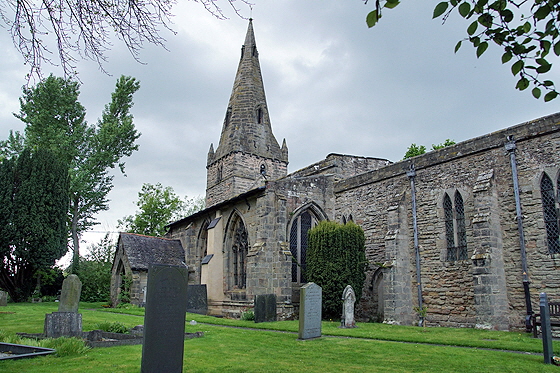 |
|
Left: The church from the north east. Right: Another view from the south. You can just make out the fine Decorated style windows of the aisle. Note the long length of the chancel. Also note the comparative rarity of small pinnacles at each corner of the broach spire.. |
|
|
|
|
Footnote - Ray State |
|
I and my friend Bonnie Herrick met Ray State by sheer good luck. He lives in the village and popped in, maybe when he saw our car parked outside! Ray proceeded to give us a rundown on all of the monuments. He knew where the alabaster was from, where the monuments were fashioned and has an encyclopaedic knowledge of the whole world of mediaeval monuments. Then we found that he had written a book, of which he had a fair quantity remaining after his publisher went bust. We promptly sent him off to get a copy each. This is the definitive book on alabaster carving in England. It tells you where and when every alabaster monument was carved, often where rthe alabaster was mined and sometimes who did the carving. It tells you about the mineralogy, the mines, the techniques. You name it. It is a doorstop of a book and itself a monument: a monument to a long line of English obsessives whose inexhaustible studies so often enlighten us. You don’t make money out of church books unless your name happens to be Jenkins. It is also a testament to the strong belief I have that the study of English churches is still an area where the enthusiastic amateur historian can make a real contribution to the sum of our knowledge. I like to thing that my own “Bums, Fleas and Hitchhikers” narrative is another example. I raise my metaphorical glass to you, Ray. |
|
I hope you have enjoyed this Page and, perhaps, many more besides. Could you help me to make it better still and preserve its future? |
